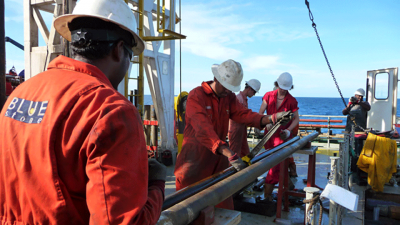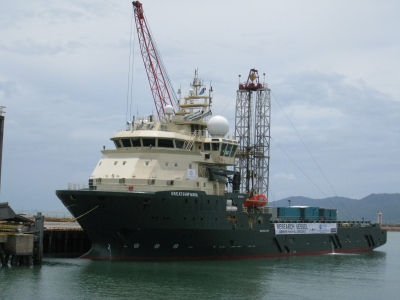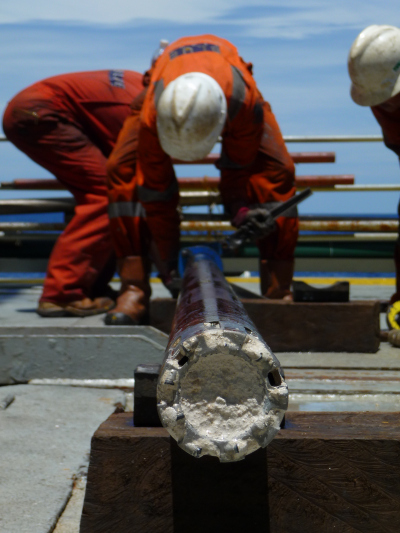Page path:
- Home
- Discover
- Media Releases
- Media Releases 2014
- 17-06-2014 Surprising Temperature Gradients In ...
Surprising Temperature Gradients In the Great Barrier Reef
Extending from the 10th to the 24th parallel (S), the Great Barrier Reef has a total length of about 2,000 kilometres. It covers an area 1.5 times the size of the United Kingdom. Over the past hundreds of thousands of years this UNESCO World Heritage Site has proven to be a highly flexible ecosystem that, in step with the rhythm of alternating glacial and warmer periods, has survived substantial fluctuations in sea level and sea-surface temperatures. The new study in Nature Communications substantiates this. It is based on investigations of cores that were drilled during an expedition of the International Ocean Discovery Program IODP in early 2010. A YouTube video shows work on board the expedition vessel Greatship Maya as well as the underwater world of the reef. The fossil coral cores were drilled along the seaward side of the Great Barrier Reef.
A few months after the expedition, participating scientists met at the IODP Core Repository in Bremen, Germany, where the cores had been sent for in-depth investigations and sampling. “After collecting specimens in Bremen, colleagues from Germany, Australia, the US, and the UK, Japan, and India continued their intense studies on the coral samples”, says first-author of the study Dr. Thomas Felis, who works at MARUM, a marine research institute at Bremen University. “In order to reconstruct the temperature regime in the Great Barrier Reef, we analysed many coral samples of the genus Isopora with a focus on two locations: one closer to the equator at the 17th parallel; the other farther from the equator at the 20th parallel.”
The researchers established the age of the corals using uranium-thorium radiometric dating techniques. The time frame represented was 25,000 to 12,000 years ago, which includes both the peak and the closing phase of the last glacial period. They then measured the strontium-calcium ratios in the corals in order to determine the ocean temperatures from that time. “Until now, relatively little has been known about how ocean temperatures rose off the eastern Australian coast during this interval of climate history,” says expedition co-chief scientist Associate Professor Jody Webster of the University of Sydney. “Today the average annual temperature at our northerly location is 26.6 degrees Celsius, while three degrees of latitude to the south it is 26.0 degrees.”
At the peak of the last glacial period, however, the water temperatures were a few degrees Celsius lower than today. The authors were particularly surprised by the north-south temperature gradient along the barrier reef. “At our southern location, farther from the equator, the water temperature during the period from 20,000 to 13,000 years ago averaged two to three degrees colder than at the northern site,” reports Dr. Helen McGregor, who previously worked at MARUM and is now a researcher at the Australian National University in Canberra. “By contrast, the temperature difference today is less than 0.6 degrees Celsius.” The authors postulate that the East Australian Current – an ocean current that transports warm tropical water southward along the eastern coast of the continent – became weaker at that time. This allowed cooler subtropical waters from the Tasman Sea to penetrate farther northward onto the barrier reef.
“Our studies show that the Isopora corals were subjected to much greater temperature fluctuations during the closing phase of the last glacial period than was previously believed,” says Dr. Thomas Felis. The question remains how they managed to adapt within a few thousand years and why the temperature stress seems not to have stopped coral growth, which is a predominant topic in discussions of coral reefs today. “On the one hand, this indicates that the corals at that time apparently were more adaptable than we could imagine so far”, suggests the Bremen marine scientist. “We cannot infer from this, however, that today’s barrier reef could be capable of easily adapting to a continued rise in ocean temperatures. After all, the temperature levels 20,000 years ago were significantly lower than those of today.”
Link to the article:
Felis, T. et al. Intensification of the meridional temperature gradient in the Great Barrier Reef following the Last Glacial Maximum. Nature Communications
Further information / interviews / images:
Albert Gerdes
MARUM Public Relations
Bremen/Germany
Tel.: 0049-421 218 65540
Email: [Bitte aktivieren Sie Javascript]
A few months after the expedition, participating scientists met at the IODP Core Repository in Bremen, Germany, where the cores had been sent for in-depth investigations and sampling. “After collecting specimens in Bremen, colleagues from Germany, Australia, the US, and the UK, Japan, and India continued their intense studies on the coral samples”, says first-author of the study Dr. Thomas Felis, who works at MARUM, a marine research institute at Bremen University. “In order to reconstruct the temperature regime in the Great Barrier Reef, we analysed many coral samples of the genus Isopora with a focus on two locations: one closer to the equator at the 17th parallel; the other farther from the equator at the 20th parallel.”
The researchers established the age of the corals using uranium-thorium radiometric dating techniques. The time frame represented was 25,000 to 12,000 years ago, which includes both the peak and the closing phase of the last glacial period. They then measured the strontium-calcium ratios in the corals in order to determine the ocean temperatures from that time. “Until now, relatively little has been known about how ocean temperatures rose off the eastern Australian coast during this interval of climate history,” says expedition co-chief scientist Associate Professor Jody Webster of the University of Sydney. “Today the average annual temperature at our northerly location is 26.6 degrees Celsius, while three degrees of latitude to the south it is 26.0 degrees.”
At the peak of the last glacial period, however, the water temperatures were a few degrees Celsius lower than today. The authors were particularly surprised by the north-south temperature gradient along the barrier reef. “At our southern location, farther from the equator, the water temperature during the period from 20,000 to 13,000 years ago averaged two to three degrees colder than at the northern site,” reports Dr. Helen McGregor, who previously worked at MARUM and is now a researcher at the Australian National University in Canberra. “By contrast, the temperature difference today is less than 0.6 degrees Celsius.” The authors postulate that the East Australian Current – an ocean current that transports warm tropical water southward along the eastern coast of the continent – became weaker at that time. This allowed cooler subtropical waters from the Tasman Sea to penetrate farther northward onto the barrier reef.
“Our studies show that the Isopora corals were subjected to much greater temperature fluctuations during the closing phase of the last glacial period than was previously believed,” says Dr. Thomas Felis. The question remains how they managed to adapt within a few thousand years and why the temperature stress seems not to have stopped coral growth, which is a predominant topic in discussions of coral reefs today. “On the one hand, this indicates that the corals at that time apparently were more adaptable than we could imagine so far”, suggests the Bremen marine scientist. “We cannot infer from this, however, that today’s barrier reef could be capable of easily adapting to a continued rise in ocean temperatures. After all, the temperature levels 20,000 years ago were significantly lower than those of today.”
Link to the article:
Felis, T. et al. Intensification of the meridional temperature gradient in the Great Barrier Reef following the Last Glacial Maximum. Nature Communications
Further information / interviews / images:
Albert Gerdes
MARUM Public Relations
Bremen/Germany
Tel.: 0049-421 218 65540
Email: [Bitte aktivieren Sie Javascript]






